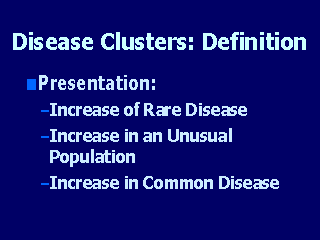|
|
|
|
front |1 |2 |3 |4 |5 |6 |7 |8 |9 |10 |11 |12 |13 |14 |15 |16 |17 |18 |19 |20 |21 |review |
 |
There are are least 3 presentations of disease clusters as enumerated
above.
The most common is the common epidemic, such as a cluster of gastroenteritis after a shared church picnic; this represents an increase in a common disease which is recognized because it occurs in a short time and space fashion in a particular group of individuals. Clusters of rare diseases are noted because of the rarity of the disease; an example would be the 3 cases of angiosarcoma of the liver associated with workers from 2 plants using vinyl chloride. Finally, sometimes the cluster is recognized in an unusual population based on known epidemiology; an example of this would be testicular cancer in male workers older than 40 years of age in a particular industry since testicular cancer is a disease of younger and much older men. In addition to the previously mentioned knowledge of underlying baseline rates of disease, it is also necessary to have either an existing surveillance system or an astute observer to notice a disease cluster. Traditionally the astute observer has been a clinician or a worker; more recently with increased awareness of environmental health effects, community people can also be astute observers. |
|
|
|
|
front |1 |2 |3 |4 |5 |6 |7 |8 |9 |10 |11 |12 |13 |14 |15 |16 |17 |18 |19 |20 |21 |review |